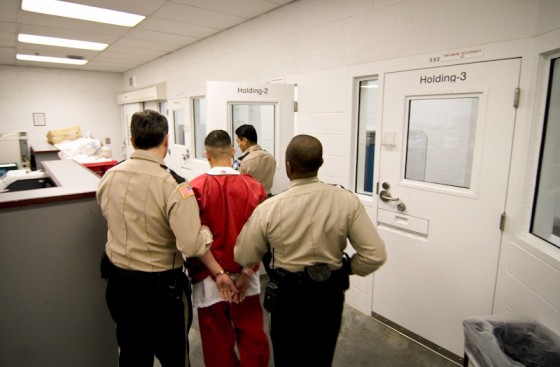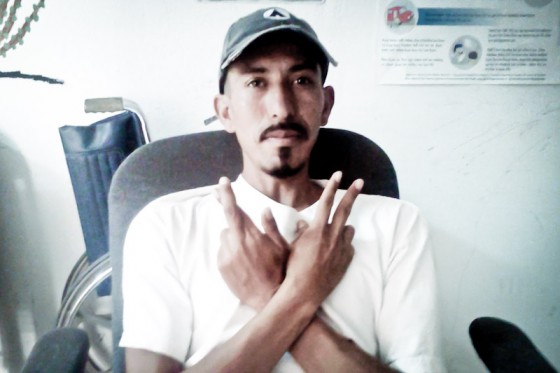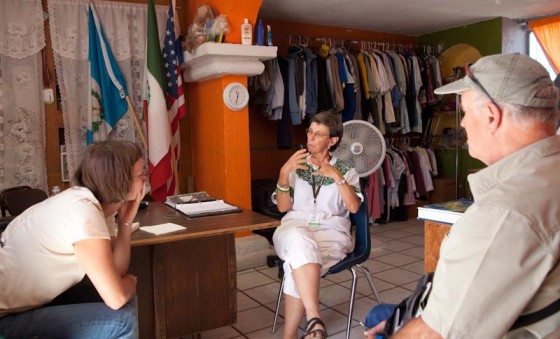Nearly half a million people are deported from the U.S. every year. Some end up here, at the tiny Migrant Resource Center in Agua Prieta, Mexico.
Two hours south of Tucson, Arizona, Agua Prieta is a small Mexican city with the bustle and grit of a stereotypical border town.
The intoxicating marriage of heat and possibility saturate its busy streets. School children buy flavored ice chips from sidewalk vendors as Mexican federales in open-air trucks languidly face their machine guns toward the passersby.
Everywhere looms the eternal backdrop of steel rods that separate this town from its American counterpart, while somewhere along its dizzying 1,951 mile border the fence lapses into scrubby desert terrain that is the ground to its live wire.
Agua Prieta is also home to a small but vital service for those who’ve just found themselves back on the Mexican side of the border. The Migrant Resource Center lies not twenty feet from the border fence and sees most migrants who have been deported by plane and bus to Agua Prieta.
It is September, 2013, and I’ve come here from my home in Chehalis, Washington to spend two weeks to volunteer, and to witness an aspect of the life-consuming process that is immigration.
It is no secret that the base of our labor force is populated with migrant workers, many on temporary work visas and others without any documents at all. In Washington state these workers supply grocery stores with produce, construct homes, clean buildings, maintain lawns, and occupy countless other unseen and underpaid trades regarded as ‘unskilled’ within the labor market.
Washington is also home to the Tacoma Northwest Detention Center, one of several privately-run, pre-deportation prisons contracted by U.S. Immigration and Customs Enforcement. The 1,575-bed facility is nestled obscurely within the industrial fringe as secluded from society as the migrants whom it detains. Typically, the inmates are held for between one and six months, with an average tax-payer cost of about $150 per day per person.
 An undocumented immigrant is booked into the Northwest Detention Center in Tacoma. (Photo by Alex Stonehill)
An undocumented immigrant is booked into the Northwest Detention Center in Tacoma. (Photo by Alex Stonehill)
To put this into perspective, the Obama Administration and Department of Homeland Security has requested $1.84 billion toward DHS Custody Operations as part of the 2014 fiscal budget — that’s enough for 13 million days of individual detention next year.
In Agua Prieta, I meet a young man who had been picked up on the outskirts of San Francisco and spent six months in the Tacoma detention center before ending up at the Migrant Resource Center. His clothes are torn and dusty and his upper arm is riddled in scabs. He doesn’t want to tell me his specific story, but rattles off the abstract threats of night, of people who are more animal than human.
He stands and paces the room in rage, then sits back down and begins to weep.
I do not know where he’s been between the moneyed construct of the private prison and the refuge of our center, but I know where he’s going. He looks determined and calm as he points to the northern wall. He’ll leave the next morning. He has no other choice.
The MRC serves as a space of peace, information and basic needs for migrants like this man, who find themselves shuffled back into Mexico and left at the border. Agua Prieta is a new city for many, who are left to their own devices without any knowledge of local resources.
Some have spent so long in the United States that Mexico is like a foreign country, while others have been nabbed by ICE in their desert crossing and are re-visiting Agua Prieta sooner-than-expected. For all, the MRC is a small candle at the end of the long, obscure deportation process executed daily in the U.S.
Here in the Center the room is dark; on the television, women newscasters jabber facts on Guerrero’s flooding while flies search halves of hamburger bun left on the long plastic tables for snack. Intermittently the center fills with the recently-deported, who, situating themselves along the wall, coolly scan posters on desert deaths and human trafficking; others pile around the television and murmur in low voices or simply sit complacently to thread through their experiences under an aura of normalcy.
 Mario (last name withheld) passed through the Migrant Resource Center before crossing into the United States, hoping to find work in a restaurant. (Photo by Madeline McClure)
Mario (last name withheld) passed through the Migrant Resource Center before crossing into the United States, hoping to find work in a restaurant. (Photo by Madeline McClure)
The station offers small amounts of water in colorful plastic cups meant for daycares, and fold-out chairs designed for the restless time of waiting rooms. At noon we produce unpalatable food assembled solely for energy, carbohydrates to carry those into the night shelter, onto the bus back home, or across the fence into the dark expanses of chance.
There is a restless energy about the room amplified by the groups of weary travelers the Mexican immigration officials assist in throughout the day. As volunteers we attempt to relay our barrage of information onto these groups before they disperse, at which point I am instructed to sit with individuals and ask them of their plans. But as I come to know the migrants and their stories, I am terrified of asking this question, fearing that they have plans to cross. I fear, too, that they will return to their home state, drained of hope and confined to poverty.
But asking questions is the best I’m capable of. I don’t have answers because there really are none for these economic refugees other than hard work and harder luck. Eventually, I compromise on immediate needs and cross the border into the United States, where I stock up on compasses from the nearest Wal-Mart, and print off aerial maps at the local library.
Soon after, I meet an energetic man from the southeast Mexican state Quintana Roo. He has a soft face and an inviting disposition. For the past several years he has been painting houses in Florida. He was seized by the border patrol after getting pulled over for a burnt-out license plate bulb, and now he is here in the MRC telling me about his plans to cross again.
He does not have money for a pollero, a desert guide typically within the lower ranks of the drug cartels, and so he figures he will cross alone. His is giddy, hopeful and full of Catholic faith. He will call me when he arrives in Phoenix. I am thinking as he tells me this of the desert that spans between the border and any urban area in Arizona.
It is barren, ruthless and has taken an innumerable amount of lives, with the official number well into the thousands. Threats include frostbite, snake bite, heat exhaustion, dehydration, poisoning from unclean water, starvation. The crossing can take several days, especially if one loses their way.
I ask him how long he will be walking. “Sixteen, no more than twenty hours,” he tells me. He’s looked it up on the internet and spoken with friends.
“How much water are you bringing?” I ask, to which he shakes his head.
“How much food?” Again, none. He doesn’t want to carry much, he confides, because he needs to move as quickly as possible.
 Madeline McClure, Jim Marx and Sr. Judy Bourg discuss the work of the Migrant Resource Center (Photo by Bob Torrez)
Madeline McClure, Jim Marx and Sr. Judy Bourg discuss the work of the Migrant Resource Center (Photo by Bob Torrez)
He won’t be alone when crossing. Besides droves of immigration officials, rural ranchers and their large swaths of land, and the polleros and their customers, humanitarian organizations have a strong commitment to providing necessary aid in this desolate zone. A Tucson-based non-profit, No More Deaths, places gallons of water in areas with high traffic volume, and provides services such as basic first-aid and abuse documentation in an attempt to end death and suffering along the border.
Organizations like No More Deaths need to take great care to obey immigration law given the oft-perceived ‘aiding and abetting’ nature of their work. But Mexico, a volunteer explains, is different. There are no such laws against aiding and abetting.
Yet when I meet the optimistic migrant on a side street in Agua Prieta and pass him the Google maps and compass, there is the guilty mimicry of a drug deal. He shoves them quickly into his pockets and promises not to tell. He thanks me profusely, as if of all the provisions he will need, these rudimentary objects have just saved his life.
Weeks later, upon returning to Washington, I am out with some friends from Mexico. We are laughing and drinking beer, and making plans for Thanksgiving. Somewhere below our joyful and commonplace conversation lies the Migrant Resource Center, lies the long bones of the border and the solitude of the Northwest Detention Center.
Someone offers another round. None of us feel the need to acknowledge these things. The reality is deafening.



Good story, glad you seem to care when most people don’t. However, the compass and map does not help with any of the issues. Getting them back to the U.S. is only going to get them charged with re-entry, which often means prison. Furthermore, providing these tools for these immigrants could easily be seen as encouraging the illegal immigration process, which is illegal under the Immigration and Nationality Act.
Section 274 felonies under the federal Immigration and Nationality Act, INA 274A(a)(1)(A):
* knowingly assists illegal aliens due to personal convictions.
While I support your stand, you must also be careful with the actions you take. I think the answer lies not only in changing American policy but also in the Mexican economy and security. People want to come to the U.S. for jobs which are few and far between in Mexico, and security which is damaged due to corruption and cartels in Mexico. The answers to help solve illegal immigration lie, in part, in these issues, but these are not easy to fix. Especially given Mexico’s lack of willingness to provide help to those who return outside of this Migrant Resource Center (though at least it’s something). Thanks for the article and your insight, it has greatly helped me with my research.